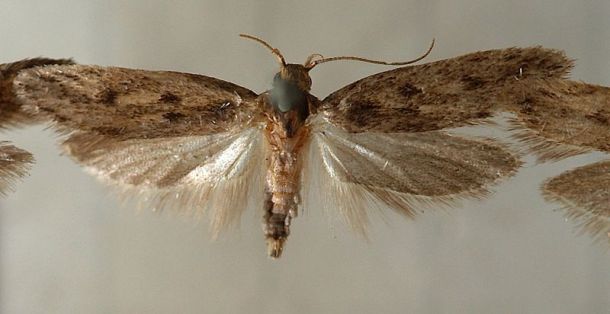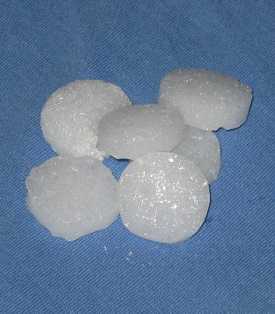The Clothes Moth and Your Ugly Christmas Sweater
Have you ever scrounged through your drawers to find that one ugly wool sweater you got last Christmas, only to find it had been mercifully torn apart by moths?
Tineola bisselliella, the clothes moth, can cause extreme damage to fabrics, furniture, books and fur. Most people know that moths can destroy clothes, but they are not just eating through the cloth to get to something else. So, what do moths eat exactly?
The short answer is keratin. But we’ll get to that, shortly.

The brown dotted clothes moth (Photo credit: Wikipedia)
The Larvae
First of all, clothes moths only consume fabrics and other such materials during one stage of their lives. Only the larval (or caterpillar) stage of clothes moths eat and destroy your ugly Christmas sweater.
The adult clothes moth lays its eggs usually between the fibres of fabrics or another area that contains a suitable food source for the eggs once they hatch.
The clothes moth larva emerges from the egg and begins feeding. The larva feeds constantly until it spins a cocoon, only stopping when it grows too large for its exoskeleton. Once the exoskeleton is shed (a process called molting), and a new larger one is formed, the larva continues eating.
The larva has a white, translucent body that only measures about 1 mm long. It has modified mouthparts that perform both tasks of eating and spinning silk. The larva then seeks out a proper meal, or large food source. Once it finds a proper place, the larva spins its silk into a fine web or tube structure around its own body. This tube extends ahead of the larva as it eats and moves around. This silken tube anchors the larva to its food source.
Why do moths eat clothes?
Most fabric fibres contain a protein called keratin. Keratin makes up the majority of human hair and nails. It acts as a structural and fibrous protein in most natural materials. Higher keratin content in a particular material makes that material tougher and stronger. Most insects cannot consume, process or digest keratin. Therefore they cannot eat a hole through wool, paper or silk.
The clothes moth can. The clothes moth has a unique ability to digest keratin. Due to the huge abundance of natural materials in most homes, and the fact that few other organisms have the ability to use such a resource, the clothes moth takes every advantage. Your clothes drawer appears to the clothes moth as a buffet that nobody else wants to eat. The clothes moth larva takes all it can eat, and leaves damaged goods in its wake.
Keeping Moths Away From Your Ugly Christmas Sweater

Mothballs (Photo credit: Wikipedia)
Some new techniques have emerged to prevent moths from laying eggs and consuming products. Some companies have implemented the use of chemicals like permethrin and cypermethrin in the actual wool itself. Other strategies, such as extreme hot or cold temperatures can kill both the adult moths and the larvae.
Some companies advise to keep anything you do not want damaged in an airtight container when not in use, such as those vacuum-sealed storage bags.
If that all seems like too much work, you could always go for the classic moth defense and use mothballs. The harsh, sharp smell of mothballs comes from a strong chemical repellent.
The scent may repel you slightly, but it repels the moths significantly more. You can keep your ugly Christmas sweater safe until next year, when you have to wear it out of courtesy to the person who made it for you.
Sources
- Cox, P. D. & Pinniger, D.B. (2007) Biology, behaviour and environmentally sustainable control of Tineola bisselliella (Hummel) (Lepidoptera: Tineidae). Journal of Stored Products Research 43(1), 2-32.